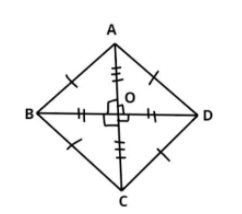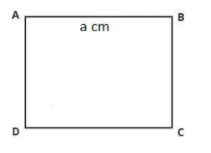Answer
424.5k+ views
Hint: In this particular question use the concept that the area of the rhombus is half times the product of the diagonals of the rhombus, and area of the square is equal to the square of its side so use these concepts to reach the solution of the question.
Complete step-by-step answer:
Given data:
Area of rhombus = Area of square = 64 sq. cm.
$ \Rightarrow {A_1} = {A_2} = 64$ Sq. cm.
It is also given that a diagonal of a rhombus is twice of its other diagonal.
Let the length of one diagonal is p cm, so the length of the other diagonal is 2p cm.
Now as we all know that the area $\left( {{A_1}} \right)$ of the rhombus is half times the product of the diagonals of the rhombus.
$ \Rightarrow {A_1} = \dfrac{{p\left( {2p} \right)}}{2}$ sq.cm.
Now substitute the value and simplify we have,
$ \Rightarrow 64 = {p^2}$
$ \Rightarrow p = \sqrt {64} = 8$ Cm.
So the length of one diagonal is 8 cm and the length of the other diagonal is 16 cm.

Now consider the rhombus as shown in above diagram the diagonal of the rhombus is always bisect and perpendicular to each other as shown in the above figure, therefore, AO = OC = $\dfrac{{AC}}{2}$ and BO = OD = $\dfrac{{BD}}{2}$
Now let, AC = p, and BD = 2p.
Therefore, AC = 8cm, and BD = 16cm.
Therefore, AO = OC = $\dfrac{{AC}}{2} = \dfrac{8}{2} = 4$cm, and BO = OD = $\dfrac{{BD}}{2} = \dfrac{{16}}{2} = 8$ cm.
Now as we all know that in a rhombus all sides are equal therefore,
AB = BC = CD = DA.
Now apply Pythagoras theorem in triangle AOB we have,
$ \Rightarrow {\left( {{\text{Hypotenuse}}} \right)^2} = {\left( {{\text{perpendicular}}} \right)^2} + {\left( {{\text{base}}} \right)^2}$
$ \Rightarrow {\left( {{\text{AB}}} \right)^2} = {\left( {{\text{OA}}} \right)^2} + {\left( {{\text{OB}}} \right)^2}$
$ \Rightarrow {\left( {{\text{AB}}} \right)^2} = {\left( {\text{4}} \right)^2} + {\left( {\text{8}} \right)^2}$
$ \Rightarrow {\left( {{\text{AB}}} \right)^2} = 16 + 64 = 80$
$ \Rightarrow AB = \sqrt {80} = 4\sqrt 5 $ Cm.
Therefore, AB = BC = CD = DA = $4\sqrt 5 $ Cm.
Now as we know that the area of the square is the square of its side.
Let the side of the square is a cm as shown in the below figure.

So the area of the square is ${A_2} = 64 = {a^2}$ sq. cm.
$ \Rightarrow a = \sqrt {64} = 8$ cm.
Now as we know that the perimeter of any shape is the sum of all the sides.
So the perimeter of the rhombus is, ${P_1} = 4\sqrt 5 + 4\sqrt 5 + 4\sqrt 5 + 4\sqrt 5 = 16\sqrt 5 $ cm.
And the perimeter of the square is, ${P_2} = 8 + 8 + 8 + 8 = 32$ cm.
So the ratio of perimeter of a square and rhombus is,
$ \Rightarrow \dfrac{{{P_2}}}{{{P_1}}} = \dfrac{{32}}{{16\sqrt 5 }} = \dfrac{2}{{\sqrt 5 }}$.
So this is the required ratio of perimeter of a square and rhombus.
Hence option (b) is the correct answer.
Note: Whenever we face such types of questions the key concept we have to remember is that that the perimeter of any shape is sum of all the sides, so first find the sides of the square as well as of the rhombus as above, then add them respectively to calculate the perimeter of square and rhombus respectively then divide the perimeter of square to rhombus as above we will get the required ratio.
Complete step-by-step answer:
Given data:
Area of rhombus = Area of square = 64 sq. cm.
$ \Rightarrow {A_1} = {A_2} = 64$ Sq. cm.
It is also given that a diagonal of a rhombus is twice of its other diagonal.
Let the length of one diagonal is p cm, so the length of the other diagonal is 2p cm.
Now as we all know that the area $\left( {{A_1}} \right)$ of the rhombus is half times the product of the diagonals of the rhombus.
$ \Rightarrow {A_1} = \dfrac{{p\left( {2p} \right)}}{2}$ sq.cm.
Now substitute the value and simplify we have,
$ \Rightarrow 64 = {p^2}$
$ \Rightarrow p = \sqrt {64} = 8$ Cm.
So the length of one diagonal is 8 cm and the length of the other diagonal is 16 cm.

Now consider the rhombus as shown in above diagram the diagonal of the rhombus is always bisect and perpendicular to each other as shown in the above figure, therefore, AO = OC = $\dfrac{{AC}}{2}$ and BO = OD = $\dfrac{{BD}}{2}$
Now let, AC = p, and BD = 2p.
Therefore, AC = 8cm, and BD = 16cm.
Therefore, AO = OC = $\dfrac{{AC}}{2} = \dfrac{8}{2} = 4$cm, and BO = OD = $\dfrac{{BD}}{2} = \dfrac{{16}}{2} = 8$ cm.
Now as we all know that in a rhombus all sides are equal therefore,
AB = BC = CD = DA.
Now apply Pythagoras theorem in triangle AOB we have,
$ \Rightarrow {\left( {{\text{Hypotenuse}}} \right)^2} = {\left( {{\text{perpendicular}}} \right)^2} + {\left( {{\text{base}}} \right)^2}$
$ \Rightarrow {\left( {{\text{AB}}} \right)^2} = {\left( {{\text{OA}}} \right)^2} + {\left( {{\text{OB}}} \right)^2}$
$ \Rightarrow {\left( {{\text{AB}}} \right)^2} = {\left( {\text{4}} \right)^2} + {\left( {\text{8}} \right)^2}$
$ \Rightarrow {\left( {{\text{AB}}} \right)^2} = 16 + 64 = 80$
$ \Rightarrow AB = \sqrt {80} = 4\sqrt 5 $ Cm.
Therefore, AB = BC = CD = DA = $4\sqrt 5 $ Cm.
Now as we know that the area of the square is the square of its side.
Let the side of the square is a cm as shown in the below figure.

So the area of the square is ${A_2} = 64 = {a^2}$ sq. cm.
$ \Rightarrow a = \sqrt {64} = 8$ cm.
Now as we know that the perimeter of any shape is the sum of all the sides.
So the perimeter of the rhombus is, ${P_1} = 4\sqrt 5 + 4\sqrt 5 + 4\sqrt 5 + 4\sqrt 5 = 16\sqrt 5 $ cm.
And the perimeter of the square is, ${P_2} = 8 + 8 + 8 + 8 = 32$ cm.
So the ratio of perimeter of a square and rhombus is,
$ \Rightarrow \dfrac{{{P_2}}}{{{P_1}}} = \dfrac{{32}}{{16\sqrt 5 }} = \dfrac{2}{{\sqrt 5 }}$.
So this is the required ratio of perimeter of a square and rhombus.
Hence option (b) is the correct answer.
Note: Whenever we face such types of questions the key concept we have to remember is that that the perimeter of any shape is sum of all the sides, so first find the sides of the square as well as of the rhombus as above, then add them respectively to calculate the perimeter of square and rhombus respectively then divide the perimeter of square to rhombus as above we will get the required ratio.
Recently Updated Pages
How many sigma and pi bonds are present in HCequiv class 11 chemistry CBSE

Why Are Noble Gases NonReactive class 11 chemistry CBSE

Let X and Y be the sets of all positive divisors of class 11 maths CBSE

Let x and y be 2 real numbers which satisfy the equations class 11 maths CBSE

Let x 4log 2sqrt 9k 1 + 7 and y dfrac132log 2sqrt5 class 11 maths CBSE

Let x22ax+b20 and x22bx+a20 be two equations Then the class 11 maths CBSE

Trending doubts
Fill the blanks with the suitable prepositions 1 The class 9 english CBSE

At which age domestication of animals started A Neolithic class 11 social science CBSE

Which are the Top 10 Largest Countries of the World?

Give 10 examples for herbs , shrubs , climbers , creepers

Difference between Prokaryotic cell and Eukaryotic class 11 biology CBSE

Difference Between Plant Cell and Animal Cell

Write a letter to the principal requesting him to grant class 10 english CBSE

Change the following sentences into negative and interrogative class 10 english CBSE

Fill in the blanks A 1 lakh ten thousand B 1 million class 9 maths CBSE



